Archive Record
Images
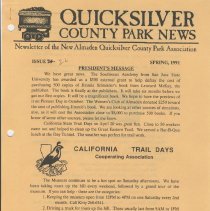

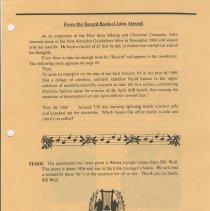
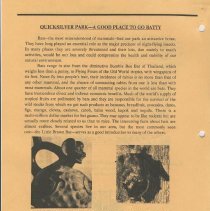
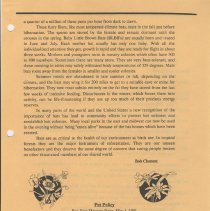
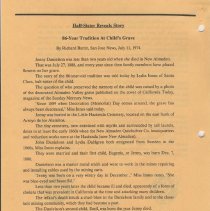
Additional Images [6]
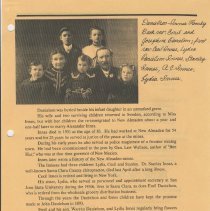
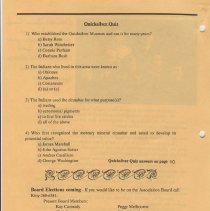
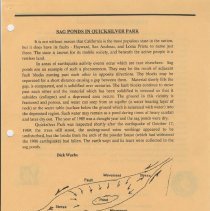
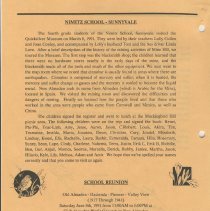
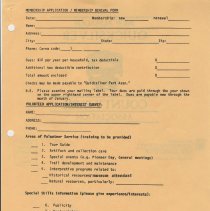
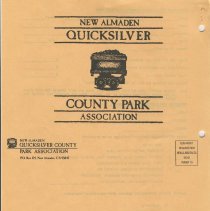
Metadata
Catalog number |
1997.2.2598 |
Object Name |
Newsletter |
Date |
1991 |
Description |
TITLE: Quicksilver County Park News SUBTITLE: Newsletter of the New Almaden Quicksilver County Park Association Issue # 26 Spring 1991 PRESIDENT'S MESSAGE We have great news. The Sourisseau Academy from San Jose State University has awarded us a $500 external grant to help defray the cost of purchasing 500 copies of Jimmie Schneider's book from Leonard McKay, the publisher. The book is finally at the publishers. It will take six months before we get our first copies. It will be a magnificent book. We hope to have the previews of it on Pioneer Day in October. The Women's Club of Almaden donated $250 toward the cost of publishing Jimmies book. We are looking at other sources of donations, also, as it will cost the Association close to $8,000 to purchase 500 books. If you know of some other sources, please let me know. California State Trail Days on April 20 was great fun. Close to 50 workers came out and helped to clean up the Great Eastern Trail. We served a Bar-B-Que lunch at the Day Tunnel. The weather was perfect for trail work. CALIFORNIA TRAIL DAYS Cooperating Association The Museum continues to be a hot spot on Saturday afternoons. We have been taking tours up the hill every weekend, followed by a grand tour of the museum. If you can help - these are the categories: 1. Keeping the museum open from 12PM to 4PM on one Saturday every 2nd month. Call Kitty 268-6547. 2. Driving a truck for tours up the hill. These usually last from 9AM to IPM on a Saturday or a Sunday. Call Kitty 268-6541. 3. Hiking tours on Saturdays and Sundays from 9AM to 1 or 2PM. Call Kitty 268-6541. 4. Opening the Museum during the weekday for school tours or bus tours. Hours and days arranged by the person agreeing to open the Museum. Dick Wachs has been doing these and I'm sure he needs help. Call Dick at 997-2153. The Santa Clara County Parks and Recreation Dept has hired a consultant to do the 4th phase of the study. This phase, called the "Risk Assessment", will take about 200 days. We hope to start capping the Hacienda tailings soon so we can begin construction of the Hacienda entrance, museum and tour facility. Your association has printed another set of 5,000 brochures. If you need some for libraries or clubs, etc; we have them at the museum. Also we reprinted Norman Pope's book, Crisis at Quicksilver. This is also at the museum for your convenience. I do hope the spring found you outside in this glorious green acreage, breathing in the new smells from the fresh wild flowers and grasses. If you haven't been on tour with the leaders, call and let's ride out together. Kitty Monahan EVENTS: 1. Hike 8:OOAM from Hacienda entrance Sat May 18, 1991 -- 2. Horse Trail Ride - Sunday May 19, 1991 10:00AM - 2:OOPM at Hacienda Entrance (Tobars) 3. Forum at Horseman's on McKean Wed May 22, 1991 7:OOPM Guests: Mike Honda - Supervisor Santa Clara County Joe Head - Councilman, City of San Jose Doug Gaynor - Director, Santa Clara County Dept. of Parks and Recreation Robert Overstreet - Director, San Jose City Recreation Parks & Community Services Madaleine von Lane - Law Trail Center Kitty Monahan - Parks Commissioner: Almaden Quicksilver Park Association Vicki Moore - Greenbelt Alliance Doug Gaynor - Parks Director SCCPD John AcGuisto - San Jose County Parks Department Horsemen Quicksilver Endurance Quicksilver County Park Association - From the Record Book of John Atwood As an employee of the New Idria Mining and Chemical Company, John Atwood came to the New Almaden Quicksilver Mine in November 1968 and stayed only ten months. He kept a record of all that he did, of events that transpired and of his thoughts. From time to time an excerpt from his "Record" will appear in the newsletter. The following entry appears on page 43: "It came to transpire on the day of our lord January 19, in the year of 1969, that a deluge of colorless, odorless, tasteless liquid known in the upper echelons of secretive scientific research as rain, did in a callous, unremitting dramatic fashion cause the erosion of the April drift bench, thus causing the cessation of development of one April drift for several days." "Feb. 28, 1969 Around 7:50 this morning lightning struck a power pole and knocked out the electricity. Which means this office trailer is cold and there's no coffee!" FLASH: The association has been given a Weber Upright piano from Bill Wulf. This piano is dated 1856 and was in the mine manager's house. We will find a wonderful place for it in the museum for all to see. Thank you so much, Bill Wulf. QUICKSILVER PARK---A GOOD PLACE TO GO BATTY Bats--the most misunderstood of mammals--find our park an attractive home. They have long played an essential role as the major predator of night-flying insects. In many places they are severely threatened and their loss, due mainly to man's activities, would be our loss and could compromise the health and stability of our natural environment. Bats range in size from the diminutive Bumble Bee Bat of Thailand, which weighs less than a penny, to Flying Foxes of the Old World tropics, with wingspans of six feet. None fly into people's hair, their incidence of rabies is no more than that of any other mammal, and the chance of contracting rabies from one is less than with most mammals. About one quarter of all mammal species in the world are bats. They have tremendous direct and indirect economic benefits. Much of the world's supply of tropical fruits are pollinated by bats and they are responsible for the survival of the wild stocks from which we get such products as bananas, breadfruit, avocados, dates, figs, mango, cloves, cashews, carob, balsa wood, kapok and tequila. There is a multi-million dollar market for bat guano. They may appear to be like rodents but are actually more closely related to us than to mice. The interesting facts about bats are almost endless. Several species live in our area, but the most commonly seen one---the Little Brown Bat---serves as a good introduction to many of the others. Little Brown Bats belong to a group of bats called "mouse-eared bats". There are about 100 species world-wide. Scientifically they are all in the genus Mvotis. M ttis lucifueus, our little friend, is the most common in Canada and the northern two-thirds of the United States. They "summer roost" in or on buildings, caves, abandoned mines, tree hollows, cliff faces or even in animal burrows. Most hibernate for the winter in caves or mines. Little Brown Bats like habitats near water. Each can consume about 600 mosquitoes per hour. A colony of 500 easily eliminates more than a quarter of a million of these pests per hour from dusk to dawn. These furry, fliers, like most temperate climate bats, mate in the fall just before hibernation. The sperm are stored by the female and remain dormant until she arouses in the spring. Baby Little Brown Bats (BLBB's) are usually born and reared in June and July. Each mother bat usually has only one baby. With all the individualized attention they get, growth is rapid and they are ready for flight in about three weeks. Mothers and youngsters roost in nursery colonies which often have 300 to 800 members. Sometimes there are many more. They are very heat-tolerant, and those roosting in attics may safely withstand body temperatures of 129 degrees. Male bats roost away from the females in smaller and cooler colonies. Summer roosts are abandoned in late summer or fall, depending on the climate, and the bats may wing it for 200 miles to get to a suitable cave or mine for hibernation. They now must subsist entirely on the fat they have stored from the last few weeks of intensive feeding. Disturbances in the winter, which forces them into activity, can be life-threatening if they use up too much of their precious energy reserves. In many parts of the world and the United States a new recognition of the importance of bats has lead to community efforts to protect bat colonies and reestablish lost colonies. Many local parks in the east and midwest can now be used in the evening without being "eaten alive" because of the bat houses which have been erected. Bats are as critical to the health of our environment as birds are. In tropical forests they are the major instrument of reforestation. They are our unseen benefactors and they deserve the same degree of concern that caring people bestow on other threatened members of our shared world. Bob Clement Pet Policy San Jose Mercury News, May 1, 1991 Pets will be allowed in the following areas of Almaden Quicksilver Park. All pets must be kept on leashes and are not allowed in any children's play areas. - Hacienda Trail, No Name Trail, Senator Mine Trail, Guadalupe Trail, portions of the Mine and New Almaden trails and Mockingbird Picnic Area. Half-Sister Reveals Story 86-Year Tradition At Child's Grave By Richard Battin, San Jose News, July 11, 1974 Jenny Danielson was less than two years old when she died in New Almaden. That was July 27, 1888, and every year since then family members have placed flowers on her grave. The story of the 86-year-old tradition was told today by Lydia Innes of Santa Clara, halt-sister of the child. The question of who preserved the memory of the child was raised by a photo of the decorated Almaden Valley grave published on the cover of California Today, magazine of the Sunday Mercury-News. "Since 1889 when Decoration (Memorial) Day comes around, the grave has always been decorated;" Miss Innes said today. Jenny was buried in the Little Hacienda Cemetery, located on the east bank of Arroyo de los Alamitos. The tiny cemetery, now entwined with myrtle and surrounded by tall laurels, dates to at least the early 1860s when the New Almaden Quicksilver Co. headquarters and reduction works were at the Hacienda (now New Almaden). John Danielson and Lydia Dahlgren both emigrated from Sweden in the 1860s, Miss Imes explains. They were married and their first child, Eugenia, or Jenny, was born Dec. 7, 1886. Danielson was a master metal smith and went to work in the mines repairing and installing cables used by the mining carts. "Jenny was born on a very wintry day in December ," Miss Innes notes. "She was blue-eyed and beautiful." Less than two years later the child became ill and died, apparently of a form of cholera that was prevalent in California at the time and attacking many children. The infant's death struck a cruel blow to the Danielson family and to the close-knit mining community, which they had become a part. The Danielson's second child, Emil, was born the year Jenny died. In 1893 John Danielson died, just three weeks after becoming the father of a third child, Josephine. On his deathbed, John Danielson asked his best friend, Alexander Innes, to care for his wife and two children. Innes, a native of Scotland, who arrived in New Almaden in 1869 and went to work at the mines as a machinist, made the promise. Danielson was buried beside his infant daughter in an unmarked grave. His wife and two surviving children returned to Sweden, according to Miss Innes, but with her children she re-immigrated to New Almaden about a year and one-half later to marry Alexander Innes. Innes died in 1931 at the age of 83. He had worked at New Almaden for 54 years and for 25 years he served as justice of the peace at the mines. During his early years he also served as police magistrate of a frontier mining town. He had been commissioned to the post by Gen. Lew Wallace, author of "Ben Hur;" who was at that time governor of New Mexico. Innes later wrote a history of the New Almaden mines. The Inneses had three children: Lydia, Cecil and Stanley. Dr. Stanley Innes, a well-known Santa Clara County chiropractor, died last April after a long illness. Cecil Innes is retired and living in New York. His sister, Lydia, who served as personnel and appointment secretary at San Jose State University during the 1930s, lives in Santa Clara, as does Emil Danielson, who is retired from the wholesale grocery distribution business. Through the years the Danielson and Innes children have kept the promise made to John Danielson in 1893. Emil and his son, Warren Danielson, and Lydia Innes regularly bring flowers to the graves of Jenny and her father, . "We are a close-knit family," Miss Innes states, "and we have been faithful." There existed in the New Almaden mining community "a common love of the country and of family life," Miss Innes explains. It was like a company policy," she notes "...a living spirit." That spirit has been preserved and cherished at the well-cared-for grave of Jenny Danielson. Quicksilver Quiz 1) Who established the Quicksilver Museum and ran it for many years? a) Betsy Ross b) Sarah Winchester c) Connie Perham d) Barbara Bush 2) The Indians who lived in this area were known as -a) Ohlones b) Apaches c) Costanoans d) (a) or (c) 3) The Indians used the cinnabar for what purpose(s)? a) trading b) ceremonial pigments c) to line fire circles d) all of the above 4) Who first recognized the mercury mineral cinnabar and acted to develop its potential value? a) James Marshall b) John Agustus Sutter c) Andres Castillero d) George Washington Quicksilver Quiz answers on page 10 Board Elections coming - If you would like to be on the Association Board call Kitty 268-6541. Present Board Members: Kay Carmody Peggy Melbourne Dick Forst Kitty Monahan Virginia Hammerness Dave Saso Sue Huggins John Slenter Friedolin Kessler Dick Wachs Ed Lewis Sue Wolfe Dutch Mapes Ron Wolfe Nancy Mason G PONDS IN QUICKSILVER PARK It is not without reason that California is the most populous state in the nation, but it does have its faults - Hayward, San Andreas, and Loma Prieta to name just three. The state is known for its mobile society, and beneath the active people is a restless land. In areas of earthquake activity events occur which are rare elsewhere. Sag ponds are an example of such a phenomenon. They may be the result of adjacent fault blocks moving past each other in opposite directions. The blocks may be separated for a short distance causing a gap between them. Material slowly fills the gap, is compacted, and is solidified over centuries. The fault blocks continue to move past each other and the material which has been solidified is stressed so that it subsides (collapse) and a depressed area occurs. The ground in this vicinity is fractured and porous, and water can seep from an aquifer (a water bearing layer of rock) or the water table (surface below the ground which is saturated with water) into the depressed region. Such water may remain as a pond during times of heavy rainfall and later dry out. The year of 1989 was a drought year and the sag ponds were dry. Quicksilver Park was inspected shortly after the earthquake of October 17, 1989; the trees still stood, the underground mine workings appeared to be undisturbed, but the bricks from the arch of the powder house (which had withstood the 1906 earthquake) had fallen. The earth wept and its tears were collected in the sag ponds. Dick Wachs NIMITZ SCHOOL - SUNNYVALE The fourth grade students of the Nimitz School, Sunnyvale visited the Quicksilver Museum on March 8, 1991. They were led by their teachers Lolly Cullen and Joan Conley, and accompanied by Lolly's husband Tom and the bus driver Linda Love. After a brief description of the history of the mining activities of Mine Hill, we toured the Museum. The first stop was the blacksmith shop; the children learned that there were no hardware stores nearby in the early days of the mine, and the blacksmith made all of the tools and much of the other equipment. We next went to the map room where we noted that cinnabar is usually found in areas where there are earthquakes. Cinnabar is composed of mercury and sulfur; when it is heated, the mercury and sulfur change to gasses and the mercury is cooled to become the liquid metal. New Almaden took its name from Almaden (which is Arabic for the Mine), located in Spain. We visited the mining room and discovered the difficulties and dangers of mining. Finally we learned how the people lived and that those who worked in the area were people who came from Cornwall and Mexico, as well as China. The children signed the register and went to lunch at the Mockingbird Hill picnic area. The following children were on the trip and signed the book: Renei, Phi-Phi, Truc-Linh, Amy, Jesse, Aaron, Jason, C.Robert, Louis, Akira, Tim, Trumaine, Imelda, Maria, Joaanna, Dawn, Christine, Cory, Jondel, Elizabeth, Lindsay, Kwesi, Elis, Rachelle, Laura, Bashir, Esmeralda, Tamara, Hila, Rosemary, Sunny, Sean, Lupe, Cindy, Charlene, Nahema, Terra, Justin, Erik L, Erik B, Richille, Ben, Gur, Anjali, Monica, Seemie, Marcella, Derick, Robby, Janice, Martha, Jason, Hilario, Kyle, Lily, Melissa, Adam and Amir. We hope that we've spelled your names correctly and that you come to visit us again. SCHOOL REUNION Old Almaden - Hacienda - Pioneer - Valley View (1917 Through 1941) Saturday June 8th, 1991 from 11:OOAM to 5:OOPM at Club Almaden Picnic Grounds in New Almaden 21350 Almaden Road Contact: Al Hansen, 1445 Branham Lane, San Jose, CA 95118-2414 (408)269-0391 Quiz Answers: 1)c,2)d,3)d,4)c |
People |
Monahan, Kitty Wachs, Richard Atwood, John Clement, Bob Innes, Lydia (Mrs. Alex) Danielson, Jennie Danielson, John Dahlgren, Lydia Innes, Alex (A.C.) |
Cataloged by |
Meyer, Bob |
